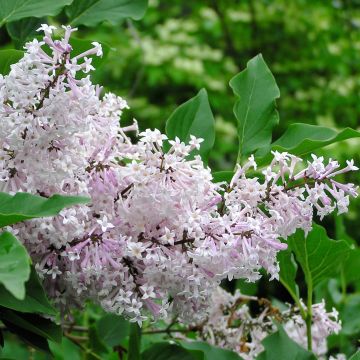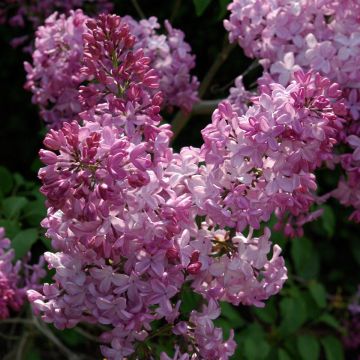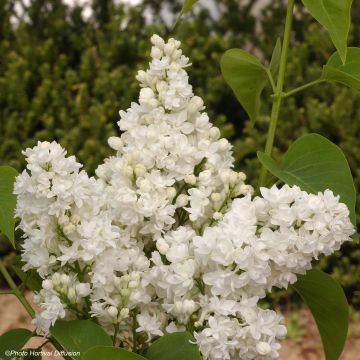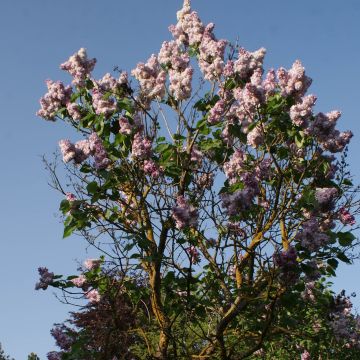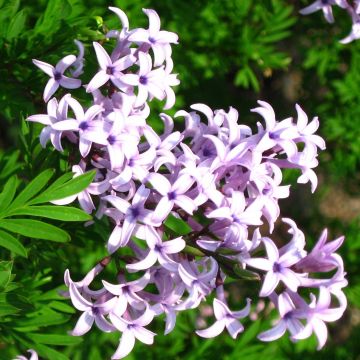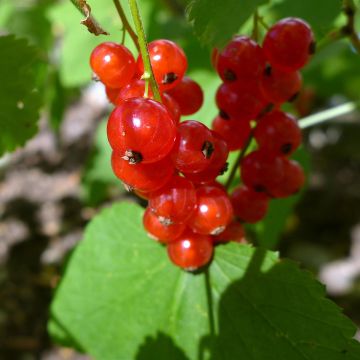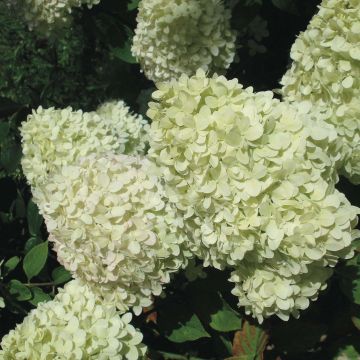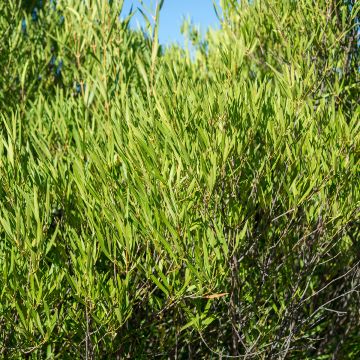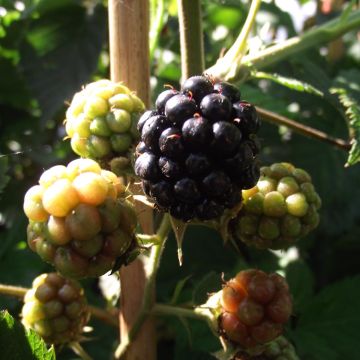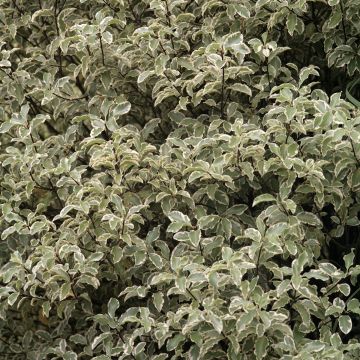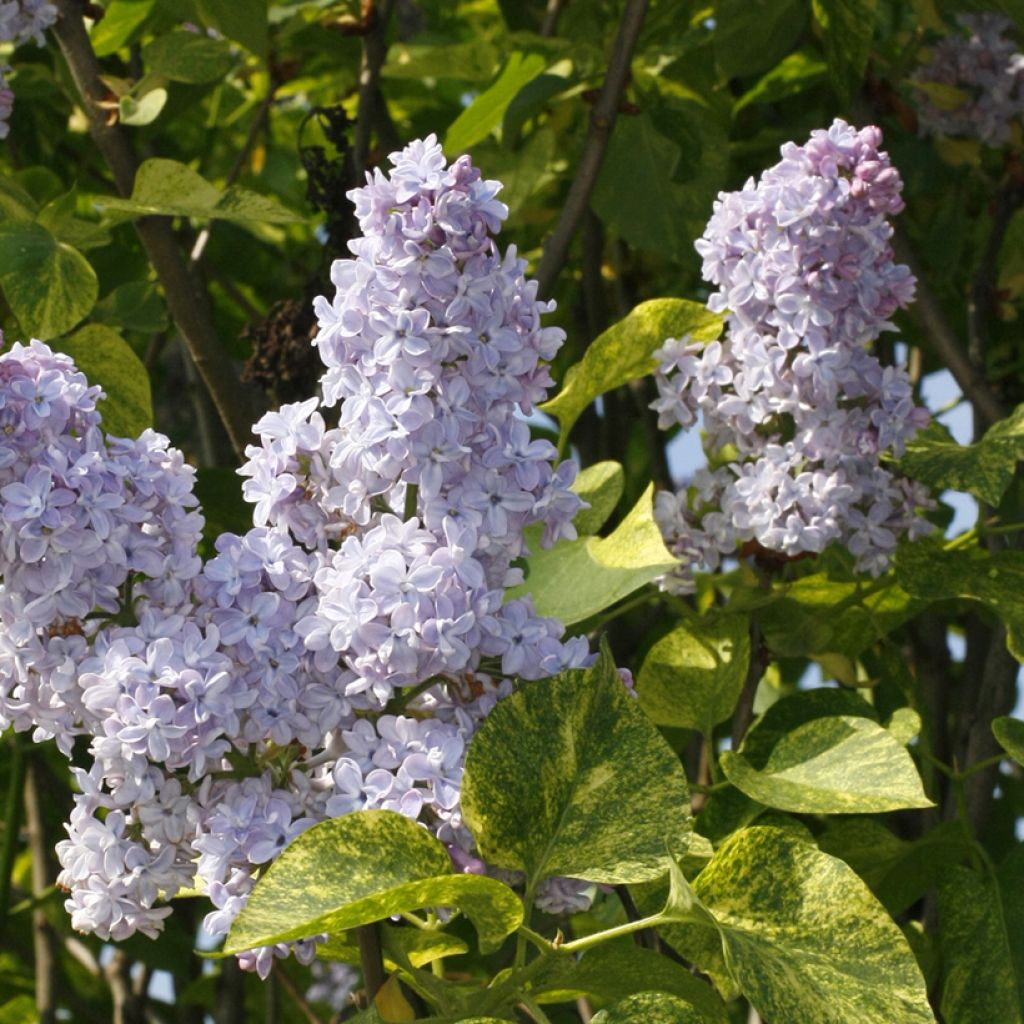

Syringa vulgaris Aucubaefolia
Syringa vulgaris Aucubaefolia
Syringa vulgaris Aucubaefolia
Common Lilac, Lilac
This item cannot be shipped to the selected country
Delivery charge from €5.90
More information
Schedule delivery date,
and select date in basket
This plant carries a 24 months recovery warranty
More information
We guarantee the quality of our plants for a full growing cycle, and will replace at our expense any plant that fails to recover under normal climatic and planting conditions.
From €5.90 for pickup delivery and €6.90 for home delivery
Express home delivery from €8.90.
Does this plant fit my garden?
Set up your Plantfit profile →
Description
The 'Aucubaefolia' Lilac was named for its variegated foliage, which resembles an aucuba. It is an original variety derived from the Syringa vulgaris, the common lilac. In spring, this deciduous small tree produces clusters of purple buds that open into fragrant flowers, more or less double, in a lovely mauve colour. Bright and refined, this lilac is fantastic in spring. It deserves to be showcased in the garden. Its flower clusters are beautiful in flower arrangements.
The Syringa vulgaris 'Aucubaefolia' is a horticultural creation derived from the lilac 'President Grevy'. It is a deciduous shrub of the olive family. The common lilac, also known as European lilac, is native to Southeast Europe and Western Asia, specifically the Balkan Peninsula. It only arrived in Western Europe at the end of the Renaissance. This robust species with highly fragrant blue-violet-purple flowers in nature covers rocky hills and withstands very cold winters.
The 'Aucubaefolia' variety is an upright and rounded shrub with an average height of 2.70 m and a spread of 1.80 m. Its stump slightly suckers, spontaneously forming a bush composed of multiple stems. Its triangular and heart-shaped deciduous leaves, measuring 4 to 12 cm long and 3 to 8 cm wide, appear in spring. They are randomly striated, splashed, or punctate with yellow on a green background. The flowering occurs between May and June, sometimes as early as April 15th, depending on the climate. Pairs or more ramified clusters appear at the ends of one-year-old branches, slightly erect. These compound clusters, called thyrses, reach 15 to 25 cm long. Their overall pyramidal shape is rather slender. The dark purple buds open into double or semi-double flowers, with a corolla forming a long tube at the base. Their colour evolves from pinkish mauve to bluish mauve. They emit a pronounced, very floral fragrance.
Falling into disuse in the 1960s-1970s, which saw the rise of more delicate and often perpetual American or Asian lilacs, the European lilac and its more massive hybrids are making a strong comeback in our gardens. Like old-fashioned roses, which were criticised for their single flowering and were therefore neglected in favour of modern hybrids, the European lilac and its more massive hybrids are making a strong comeback in our gardens.
The 'Aucubaefolia' Common Lilac is a shrub of real ornamental value. It adapts to any well-drained soil in almost all climates. Highlight it against a background of conifers or shrubs with dark foliage. It is also used in large flowering hedges, along with other lilac varieties, ornamental cherry trees, or apple trees. All these shrubs planted above a sunken path will delight in spring. It can also be used as a standalone plant, surrounded by a bed of ground cover roses like 'The Fairy', in a small dedicated space.
Report an error about the product description
Syringa vulgaris Aucubaefolia in pictures
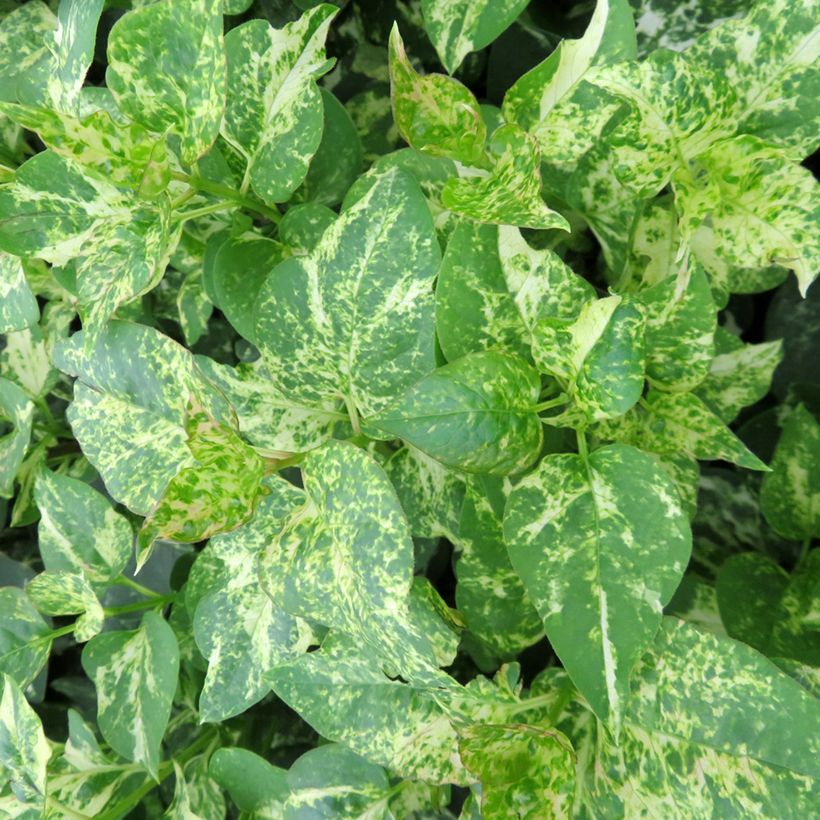

Plant habit
Flowering
Foliage
Botanical data
Syringa
vulgaris
Aucubaefolia
Oleaceae
Common Lilac, Lilac
Cultivar or hybrid
Other Syringa - Lilac
Planting and care
The Common Lilac Aucubaefolia thrives in full sun, deep, dry soil, and even clay-limestone. It tolerates all types of soil, but prefers slightly chalky soils and fears frankly acidic soils. It will grow well in semi-shade but will flower less. It is incredibly hardy, growing above -15°C. Easy to grow, its only maintenance requirements are mulching and regular watering in summer in dry climates to maintain a certain level of humidity. Although the common lilac thrives in warmer climates, its large-flowered hybrids suffer from a lack of water, which disfigures their thirsty vegetation. In any case, water it in the first few years if there is a marked drought. You can prune the flowering branches to produce beautiful bouquets or, at the end of flowering, encourage new flowers to appear and avoid tiring the shrub. Avoid severe pruning, limiting flowering until spring unless your Lilac grows too large.
Planting period
Intended location
Care
This item has not been reviewed yet - be the first to leave a review about it.
Hedge shrubs
Haven't found what you were looking for?
Hardiness is the lowest winter temperature a plant can endure without suffering serious damage or even dying. However, hardiness is affected by location (a sheltered area, such as a patio), protection (winter cover) and soil type (hardiness is improved by well-drained soil).

Photo Sharing Terms & Conditions
In order to encourage gardeners to interact and share their experiences, Promesse de fleurs offers various media enabling content to be uploaded onto its Site - in particular via the ‘Photo sharing’ module.
The User agrees to refrain from:
- Posting any content that is illegal, prejudicial, insulting, racist, inciteful to hatred, revisionist, contrary to public decency, that infringes on privacy or on the privacy rights of third parties, in particular the publicity rights of persons and goods, intellectual property rights, or the right to privacy.
- Submitting content on behalf of a third party;
- Impersonate the identity of a third party and/or publish any personal information about a third party;
In general, the User undertakes to refrain from any unethical behaviour.
All Content (in particular text, comments, files, images, photos, videos, creative works, etc.), which may be subject to property or intellectual property rights, image or other private rights, shall remain the property of the User, subject to the limited rights granted by the terms of the licence granted by Promesse de fleurs as stated below. Users are at liberty to publish or not to publish such Content on the Site, notably via the ‘Photo Sharing’ facility, and accept that this Content shall be made public and freely accessible, notably on the Internet.
Users further acknowledge, undertake to have ,and guarantee that they hold all necessary rights and permissions to publish such material on the Site, in particular with regard to the legislation in force pertaining to any privacy, property, intellectual property, image, or contractual rights, or rights of any other nature. By publishing such Content on the Site, Users acknowledge accepting full liability as publishers of the Content within the meaning of the law, and grant Promesse de fleurs, free of charge, an inclusive, worldwide licence for the said Content for the entire duration of its publication, including all reproduction, representation, up/downloading, displaying, performing, transmission, and storage rights.
Users also grant permission for their name to be linked to the Content and accept that this link may not always be made available.
By engaging in posting material, Users consent to their Content becoming automatically accessible on the Internet, in particular on other sites and/or blogs and/or web pages of the Promesse de fleurs site, including in particular social pages and the Promesse de fleurs catalogue.
Users may secure the removal of entrusted content free of charge by issuing a simple request via our contact form.
The flowering period indicated on our website applies to countries and regions located in USDA zone 8 (France, the United Kingdom, Ireland, the Netherlands, etc.)
It will vary according to where you live:
- In zones 9 to 10 (Italy, Spain, Greece, etc.), flowering will occur about 2 to 4 weeks earlier.
- In zones 6 to 7 (Germany, Poland, Slovenia, and lower mountainous regions), flowering will be delayed by 2 to 3 weeks.
- In zone 5 (Central Europe, Scandinavia), blooming will be delayed by 3 to 5 weeks.
In temperate climates, pruning of spring-flowering shrubs (forsythia, spireas, etc.) should be done just after flowering.
Pruning of summer-flowering shrubs (Indian Lilac, Perovskia, etc.) can be done in winter or spring.
In cold regions as well as with frost-sensitive plants, avoid pruning too early when severe frosts may still occur.
The planting period indicated on our website applies to countries and regions located in USDA zone 8 (France, United Kingdom, Ireland, Netherlands).
It will vary according to where you live:
- In Mediterranean zones (Marseille, Madrid, Milan, etc.), autumn and winter are the best planting periods.
- In continental zones (Strasbourg, Munich, Vienna, etc.), delay planting by 2 to 3 weeks in spring and bring it forward by 2 to 4 weeks in autumn.
- In mountainous regions (the Alps, Pyrenees, Carpathians, etc.), it is best to plant in late spring (May-June) or late summer (August-September).
The harvesting period indicated on our website applies to countries and regions in USDA zone 8 (France, England, Ireland, the Netherlands).
In colder areas (Scandinavia, Poland, Austria...) fruit and vegetable harvests are likely to be delayed by 3-4 weeks.
In warmer areas (Italy, Spain, Greece, etc.), harvesting will probably take place earlier, depending on weather conditions.
The sowing periods indicated on our website apply to countries and regions within USDA Zone 8 (France, UK, Ireland, Netherlands).
In colder areas (Scandinavia, Poland, Austria...), delay any outdoor sowing by 3-4 weeks, or sow under glass.
In warmer climes (Italy, Spain, Greece, etc.), bring outdoor sowing forward by a few weeks.


































